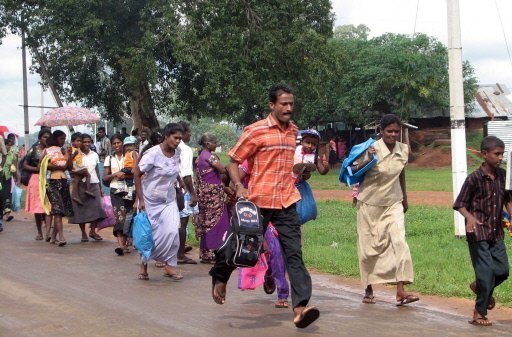Ilankai Tamil Sangam30th Year on the Web Association of Tamils of Sri Lanka in the USA |
||||
 Home Home Archives Archives |
Most Refugees Still in Transit Campsby Ranga Sirilal, Reuters, December 4, 2009
Most Sri Lankan refugees resettled from large military-run camps since the end of a 25-year civil war in May are still in transit facilities while de-mining work is finished, the government said on Friday. Human Rights and Disaster Management Minister Mahinda Samarasinghe said 70 percent of the more than 280,000 refugees who fled the end of the war against the Tamil Tigers had been relocated from the main camps. "The bulk of them are still in temporary facilities. It's a transit camp until the de-mining is completed. There is quite a number in Kilinochchi and Mullaitivu," he said, referring to two former rebel-held districts in northern Sri Lanka. On Tuesday, the government gave all those resident in the main camps permission to leave temporarily to find work or seek out relatives, answering months of international criticism over freedom of movement restrictions. The U.N. High Commissioner for Refugees on Friday said at least 7,000 people had left the camps on the first day, and that more were leaving to find family members and visit centres where those with suspected Tamil Tiger rebel links are being held. "We are encouraged by the Sri Lankan government's long-awaited decision this week to allow increased freedom of movement for some 135,000 internally displaced people," UNHCR said in a statement. The government had earlier resisted pressure to let people out, saying they first had to be screened to ensure they did not have links to the Tamil Tigers and their home areas cleared of landmines. UNHCR urged swift progress in demining. The refugees' situation has grown into a big political issue since the end of the war, especially now that former army commander General Sarath Fonseka will challenge incumbent President Mahinda Rajapaksa at an election due on Jan. 26. Although Fonseka was frequently criticised by opposition parties as he led the army to victory, they have since courted him as a common candidate for a patchwork coalition designed solely to defeat Rajapaksa. In May, Sri Lanka crushed the Tigers and ended their quarter-century war to create a separate nation for the Tamil ethnic minority on the island of 21 million people, three-quarters of whom are from the Sinhalese ethnic group. As the military advanced relentlessly in the final year of the war, the Tigers had with them nearly 300,000 Tamils who the United Nations and others said were being kept as human shields. Most were brought by force, although some backed the Tigers. |
|||
|
||||
